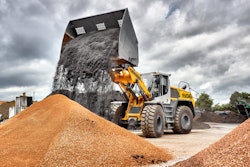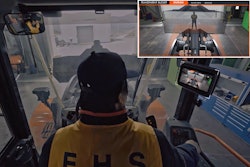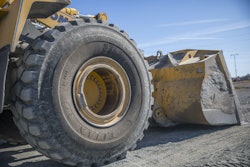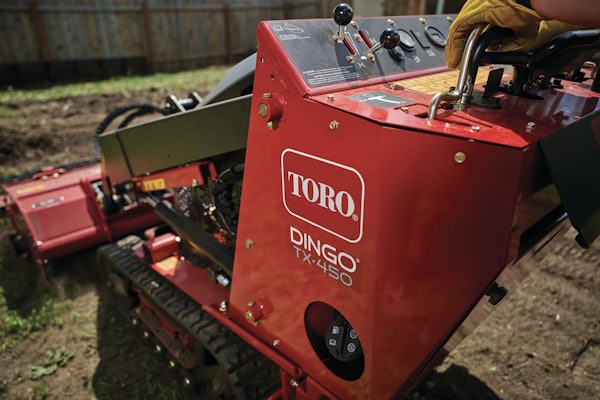After hearing visibility concerns from customers, Doosan came up with an industry-first: a see-through loader bucket. But how does the system work? And what type of impact could it have on the industry? Check out the video for all the details.
It’s not extremely often when covering the construction equipment industry that you see an innovation or new feature introduced to the market that has the potential to really make an impact on machines for many years to come.
But I think we've got one here.
I think the last time I recognized one was back in 2013 when Komatsu first launched its intelligent Machine Control (iMC) Platform on the D61-23—the first fully integrated machine control system.
Obviously that system has grown and spread into more Komatsu machines. Plus competing brands like Cat and Deere followed with their own fully-integrated systems from the factory—Cat Grade and SmartGrade, respectively. So, looking back at the launch of iMC in 2013—that was an industry-changing technology.
Now, I think it’s Doosan’s turn with their new transparent bucket technology—launching first on their completely redesigned next generation Dash-7 loaders.
Obviously, the bucket isn’t actually transparent. Doosan hasn’t developed some type of acrylic or glass bucket. And even if they had you’d still have the material in the bucket obstructing your view. And they haven’t been able to pull some type of high-tech cloaking technology from the depths of military development or Star Trek.
Rather they’re implementing a smart use of existing technology to solve a considerable safety and efficiency problem for loader operators—especially those in load and carry applications.
To explain what this system does, it’s helpful to first explain what problem Doosan is trying to solve.
The problem
Over the years loader manufactures have made great strides in the way of increasing visibility from the cab thanks to increases in the amount of glass in the overall cab structure. Doosan’s latest loaders are no exception. But one big obstruction to visibility can’t be solved with more glass—and that’s the bucket.
No matter if you’re carrying low or high, whatever is beyond that bucket is out of sight, requiring operators to have great memories in terms of what the jobsite around them looks like, and to move very cautiously as they crane their necks to see around the bucket. Even something as simple and tedious as approaching a truck, sometimes needs to be done with that quick check to see where the side of the bed is in relation to the bucket.
I doubt the bucket’s obstruction has occurred to many as a “problem” needing to be solved. But when you think about the time that could be saved and how much safer an operation could be if you could see “through” the bucket, the potential time savings starts to add up.
The solution
Doosan is solving this with a bit of AR or augmented reality technology. And like any AR solution, Doosan is using cameras and the in-cab display to help you see this augmented view of the jobsite—sans bucket.
To do that, Doosan says the system uses two cameras—one mounted high on the machine atop the cab, and another mounted low on the machine, essentially between the front wheels right under the linkage.
The reason there are two cameras is that the bucket moves in two directions—up and down. When the bucket is low, it’s obstructing the view of the low camera, but the high camera has a clear view of everything. When it’s high, the high camera can’t see, but the low camera now has a clear view.
But the system doesn't just switch between these two views as situations change. It's smarter than that.
The system stitches those two camera views together in real time. As the loader moves through the site, an on-board video controller will automatically use each of those camera views to compensate for what the other can’t see.
The result is a wide, unobstructed view of what’s in front of you and right beyond the bucket on that in-cab display.
The quick concept video that Doosan provided us with (seen in our full video above) shows the safety potential this system has in avoiding objects or obstacles that are low or on the ground and otherwise out of the operator’s field of view.
But the most practical use will be in approaching a pile or a when loading trucks. Being able to see those two situations without obstruction will likely be a big deal for many operators.
Future impact
Like I said at the top, I feel like this technology has the potential to be everywhere in a few years. Doosan is the first, but I wouldn’t be surprised if this becomes an industry-standard on wheel loaders just as the backup camera has become.
It really is the development of the backup camera in both the automotive and off-highway worlds that you can thank for a technology like this. The progression of that technology first led to those bird’s eye view camera systems that also stitch several camera views together to allow you to not only see behind the vehicle but also above and all around it. Hyundai was first in bringing those bird’s eye views to heavy equipment.
Using the bird’s eye view as inspiration, GM launched the first ever transparent trailer on its 2020 model year heavy duty trucks.
Like Doosan’s transparent bucket, the transparent trailer system stitches together views from both the rear and sides of the truck and the rear of the trailer to allow you to see what’s behind the trailer as if it weren’t there.
Doosan says this specific feature—a transparent bucket—was not specifically asked for by customers. Instead, it was a technology identified by Doosan execs and engineers and implemented in order to provide a solution for a longstanding problem with loaders—visibility.
There's even more reason for thinking this technology could be big when you consider that we’re just at the beginning stages of seeing how augmented reality technology is going to impact our world.
One day, instead of this transparent bucket view being constrained to the in-cab display, that view could instead be projected into the front glass of the loader itself. And as remote operation technology such as Cat Command, take hold in the next several years, these camera views would potentially be augmented in real time.
Regardless of how far this technology spreads, today the end result is an increase to operator safety and convenience and a reduction in fatigue.
The transparent bucket will be an available option on the new Dash-7 generation loaders starting in July.














